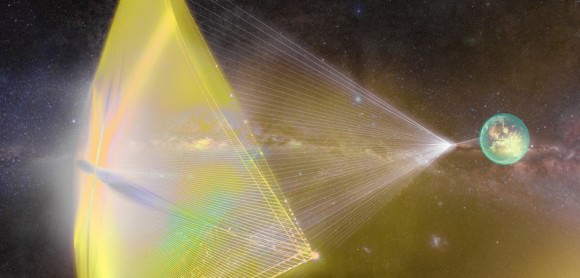Finding examples of intelligent life other than our own in the Universe is hard work. Between spending decades listening to space for signs of radio traffic – which is what the good people at the SETI Institute have been doing – and waiting for the day when it is possible to send spacecraft to neighboring star systems, there simply haven’t been a lot of options for finding extra-terrestrials.
But in recent years, efforts have begun to simplify the search for intelligent life. Thanks to the efforts of groups like the Breakthrough Foundation, it may be possible in the coming years to send “nanoscraft” on interstellar voyages using laser-driven propulsion. But just as significant is the fact that developments like these may also make it easier for us to detect extra-terrestrials that are trying to find us.
Not long ago, Breakthrough Initiatives made headlines when they announced that luminaries like Stephen Hawking and Mark Zuckerberg were backing their plan to send a tiny spacecraft to Alpha Centauri. Known as Breakthrough Starshot, this plan involved a refrigerator-sized magnet being towed by a laser sail, which would be pushed by a ground-based laser array to speeds fast enough to reach Alpha Centauri in about 20 years.
In addition to offering a possible interstellar space mission that could reach another star in our lifetime, projects like this have the added benefit of letting us broadcast our presence to the rest of the Universe. Such is the argument put forward by Philip Lubin, a professor at the University of California, Santa Barbara, and the brains behind Starshot.
In a paper titled “The Search for Directed Intelligence” – which appeared recently in arXiv and will be published soon in REACH – Reviews in Human Space Exploration – Lubin explains how systems that are becoming technologically feasible on Earth could allow us to search for similar technology being used elsewhere. In this case, by alien civilizations. As Lubin shared with Universe Today via email:
“In our SETI paper we examine the implications of a civilization having directed energy systems like we are proposing for both our NASA and Starshot programs. In this sense the NASA (DE-STAR) and Starshot arrays represent what other civilizations may possess. In another way, the receive mode (Phased Array Telescope) may be useful to search and study nearby exoplanets.”
DE-STAR, or the Directed Energy System for Targeting of Asteroids and exploRation, is another project being developed by scientists at UCSB. This proposed system will use lasers to target and deflect asteroids, comets, and other Near-Earth Objects (NEOs). Along with the Directed Energy Propulsion for Interstellar Exploration (DEEP-IN), a NASA-backed UCSB project that is based on Lubin’s directed-energy concept, they represent some of the most ambitious directed-energy concepts currently being pursued.

Using these as a template, Lubin believes that other species in the Universe could be using this same kind of directed energy (DE) systems for the same purposes – i.e. propulsion, planetary defense, scanning, power beaming, and communications. And by using a rather modest search strategy, he and colleagues propose observing nearby star and planetary systems to see if there are any signs of civilizations that possess this technology.
This could take the form of “spill-over”, where surveys are able to detect errant flashes of energy. Or they could be from an actual beacon, assuming the extra-terrestrials us DE to communicate. As is stated in the paper authored by Lubin and his colleagues:
“There are a number of reasons a civilization would use directed energy systems of the type discussed here. If other civilizations have an environment like we do they might use DE system for applications such as propulsion, planetary defense against “debris” such as asteroids and comets, illumination or scanning systems to survey their local environment, power beaming across large distances among many others. Surveys that are sensitive to these “utilitarian” applications are a natural byproduct of the “spill over” of these uses, though a systematic beacon would be much easier to detect.”
According to Lubin, this represents a major departure from what projects like SETI have been doing during the last few decades. These efforts, which can be classified as “passive” were understandable in the past, owing to our limited means and the challenges in sending out messages ourselves. For one, the distances involved in interstellar communication are incredibly vast.

Even using DE, which moves at the speed of light, it would still take a message over 4 years to reach the nearest star, 1000 years to reach the Kepler planets, and 2 million years to the nearest galaxy (Andromeda). So aside from the nearest stars, these time scales are far beyond a human lifetime; and by the time the message arrived, far better means of communication would have evolved.
Second, there is also the issue of the targets being in motion over the vast timescales involved. All stars have a transverse velocity relative to our line of sight, which means that any star system or planet targeted with a burst of laser communication would have moved by the time the beam arrived. So by adopting a pro-active approach, which involves looking for specific kinds of behavior, we could bolster our efforts to find intelligent life on distant exoplanets.
But of course, there are still many challenges that need to be overcome, not the least of which are technical. But more than that, there is also the fact that what we are looking for may not exist. As Lubin and his colleagues state in one section of the paper: “What is an assumption, of course, is that electromagnetic communications has any relevance on times scales that are millions of years and in particular that electromagnetic communications (which includes beacons) should have anything to do with wavelengths near human vision.”
In other words, assuming that aliens are using technology similar to our own is potentially anthropocentric. However, when it comes to space exploration and finding other intelligent species, we have to work with what we have and what we know. And as it stands, humanity is the only example of a space-faring civilization known to us. As such, we can hardly be faulted for projecting ourselves out there.
Here’s hoping ET is out there, and relies on energy beaming to get things done. And, fingers crossed, here’s hoping they aren’t too shy about being noticed!
Further Reading: arXiv


SETI has an observation technique that should net an answer, either positive or negative, within a few decades IIRC their own description.
Presumably optic DE would be close to our atmospheric window, since habitable terrestrials share it.
A problem with the article is that I can’t understand how and why a nanoscale light sail would drag a refrigerator size magnet around when the sail maneuvers, and the concept page in the link doesn’t mention it.
Nitpick: The closest known galaxy is the Sagittarius Dwarf Sperical at 80 klyrs. There appears to be 20 known galaxies closer to MW than Andromeda, including many spiral galaxies what I can see. [ https://en.wikipedia.org/wiki/List_of_nearest_galaxies ]
Andromeda is the gravitationally dominant galaxy in our local neighborhood.
I know, I know. But Andromeda is the closest major galaxy, and not some little dwarf one that we only started to notice with IR astronomy
Why we always must assume that moving something wirh the speed of light is the only way to reach other worlds beyond ours ? Perhaps all of the axioms, laws of physics that we observed, detected, adopted, defined, and described represent only our way of seeing the reality ? Perhaps we don’t need to “travel” anywhere through vast “emptiness” of space and time to get everywhere we want ? Perhaps exits something like simultaneous manifestation of reality in different parts of Universe ( the distances being only our illusion, because that’s how we look at things ?).
@Krystof63: The answer comes down to simple practicality — FTL, or inter-dimensional, or other forms of travel bypassing the so-called “Universal Speed Limit” may eventually be possible, but at the moment we have no idea how to make any of them work. With this in mind, the question necessarily becomes “How might WE explore space,” rather than “How might we SOMEDAY IN THE FUTURE explore space,” and the only workable answer to date are via means which obey that speed limit and the other rules of the universe as we understand them.
To that far too optimistic title I would respond : Fermi’s Paradox.
Consider the fact that our methods for searching for other sentient species in its infancy, and the fact that the Fermi Paradox will be resolved the second we discover evidence of other intelligent life. Knowing what we should be looking for, and developing broader strategies to find the “low hanging fruit” will better the odds of doing so.
Given the factors that motivate evolution I tend toward the ideas of writer Cixin Liu, it’s a dark forest out there and we are probably fluffy little bunnies compared to some. Advertising our presence is probably not a good idea and others may think the same and be more discreet, making them harder to find.
There is a line of thought that remaining undiscovered is a logical survival strategy because we have no idea what’s out there; active SETI schemes may be suicidal gestures.
Question: How do they propose to communicate their findings back to earth?